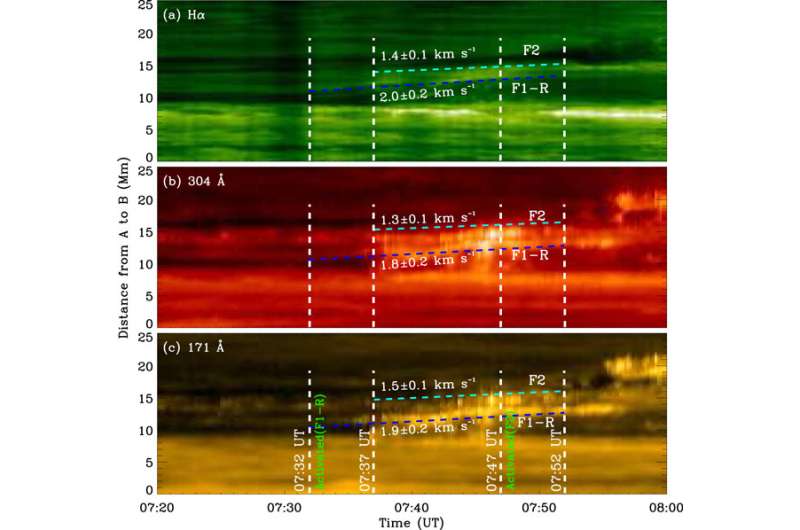Interaction between two filaments plays a key role in sympathetic filament eruptions

Solar sympathetic filament eruptions usually involve two or more filament eruptions that occur simultaneously or successively within a relatively short time interval with a certain causal linkage. The eruption of one filament may have an effect on another one, thus resulting in the eruption of the other filament simultaneously or successively.
Researchers led by Dr. Yang Liping and Prof. Yan Xiaoli from the Yunnan Observatories of the Chinese Academy of Sciences have studied the interaction process between two nearby filaments in the active region NOAA 12866 on September 9, 2021, using data from the 1-m New Vacuum Solar Telescope (NVST) and the Solar Dynamic Observatory (SDO).
The study was published in The Astrophysical Journal on Jan. 25.
They found that the right part of the larger filament became active first and erupted after appearance of the brightening and bidirectional flows between the larger filament and a near smaller filament. During its eruption process, it continuously approached the smaller filament. Then they collided with each other, and the interaction happened between them. In the following, the brightening and bidirectional flows appeared between them.
“This implies that magnetic reconnection occurred between the threads of two filaments,” said Dr. Yang. The interaction resulted in a rightward motion of the smaller filament at first, and then its activation, and finally a part of it erupted. When the erupted smaller filament deflected rapidly toward the middle part of the larger filament, the left part of the larger filament erupted with its overlying magnetic fields disturbed by the smaller filament.
Furthermore, the researchers found that the two filaments had opposite signs of helicity, and when they collided with each other at a smaller contact angle of less than 45°, the magnetic reconnection between them would happen.
“These successive eruptions occurred in a relatively short time with a certain causal linkage, and their eruptions were caused by filament interaction, which can be called sympathetic eruptions,” said Prof. Yan.
This study provides new clues for understanding solar sympathetic eruptions and for studying the continuous explosions of stars or other celestial bodies.
More information:
Liping Yang et al, Sympathetic Partial Filament Eruptions Caused by the Interaction between Two Nearby Filaments, The Astrophysical Journal (2023). DOI: 10.3847/1538-4357/aca9d2
Citation:
Interaction between two filaments plays a key role in sympathetic filament eruptions (2023, February 3)
retrieved 3 February 2023
from https://phys.org/news/2023-02-interaction-filaments-plays-key-role.html
This document is subject to copyright. Apart from any fair dealing for the purpose of private study or research, no
part may be reproduced without the written permission. The content is provided for information purposes only.
For all the latest Science News Click Here
For the latest news and updates, follow us on Google News.

